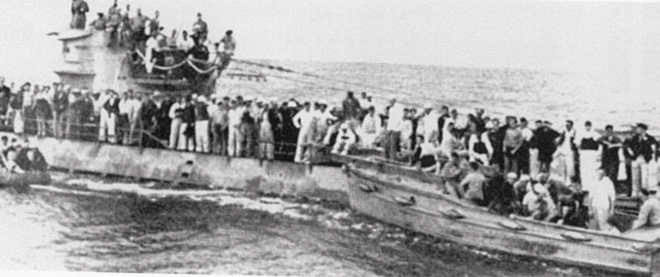Sunk and then bombed in Berlin
The extraordinary story of Canadian women who made their way back home
Share

For a Canadian book published in the middle of the Second World War, Free Trip to Berlin was an arresting title. Certainly Carolyn Gossage thought so when she encountered it listed in a reference library. Pulling at the threads in Isabel Guernsey’s memoir eventually yielded the extraordinary story Gossage captures in The Accidental Captives. There are entire bookshelves dedicated to the effects of the war, the greatest upheaval in human history, on the Canadian home front (in every sense), but Gossage’s book is one of a handful to show it wasn’t only male soldiers who spent some dangerous times behind enemy lines.
Guernsey had been a passenger on the Zamzam, a decrepit British ship hastily kitted out as a neutral Egyptian liner. Setting out on a fingers-crossed run from New York to Cape Town in March 1941, the Zamzam carried a very mixed bag of more than 200 passengers, including 34 children. The majority were missionaries, mostly American but with a sprinkling of Canadians, from 20 different Christian denominations, all bound for Africa to replace—ironically enough, as it turned out—the German missionaries there who had been interned by the British.
The missionaries were joined in uneasy companionship by two dozen boisterous and hard-drinking American volunteers for an Anglo-American ambulance unit formed to serve with Gen. Charles de Gaulle’s Free French in North Africa, six equally bar-propping North Carolina tobacco executives responding to a British invitation to help establish their industry in what is now Zimbabwe, and a handful of random individuals. Most of those were women with deeply personal aims of their own, including Guernsey. In her mid-30s, well-educated (an M.A. in French from UBC), and from a well-to-do Vancouver family, Guernsey—on a visit home— had been trapped in Canada by the outbreak of the war, and wanted to rejoin her geologist husband in South Africa.
On April 17, only three days away from Cape Town, the Zamzam was sunk by the Atlantis, one of the most famous German raiders of the war. The rescued passengers were taken to occupied France before the Americans were sent home. That left 28 “belligerent nationals,” mostly Canadian, in custody. The women and children ended up in the German internment camp at Liebenau, already home to 300 other British passport holders. Guernsey, who Gossage in an interview calls “the natural leader,” began badgering the camp inspector for access to American consular staff. He, in turn, seizing on a chance to reduce the numbers in his care, took advantage of the fact Canada and South Africa had not (yet) interned all the German women within their borders. He collected 14 child-free volunteers—seven Canadian Zamzammers, as they called themselves, two other Canadians and five South Africans—and packed them off to Berlin in September 1941, after writing in their passports they were now the responsibility of the U.S. embassy. It was only after they arrived that the women realized this was news to the Americans.
But the ever-dwindling band of American diplomats in the Reich’s capital responded handsomely, finding hotel rooms and ration cards and arranging to funnel money from Canada and South Africa. The women would end up spending eight months in Berlin, their days dominated by lining up for food—though they were helped there by the lucky discovery of a butcher with only pleasant memories of his time in British captivity during the Great War—and their nights by dodging bombs dropped by their own air force. Some began to study German and to teach English, “which helped pay for cocktails at the Adlon hotel,” notes Gossage, “which is where they met P. G. Wodehouse.”
But the Canadians had not actually been forgotten by Ottawa. The entrance of the Americans into the war in December made the women’s living conditions appreciably more bleak, but it also offered an opportunity Canadian officials jumped on. They managed to get the Zamzammers on to a special transport for stranded Americans. By slow train to Lisbon, and then ship to New York, the Canadians returned to where they had set out 15 months earlier.
They still got home much faster than some Zamzam passengers, notes Gossage. Among those 28 belligerents taken off the Egyptian liner were 17 Africa-bound French Canadian priests. The Nazis refused to let them go: the priests were dispersed among stalags and concentration camps far more harsh than Liebenau, where they served as chaplains to Catholic POWs and slave labourers until the war’s end. Theirs too is a story that deserves to be resurrected.